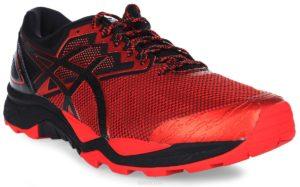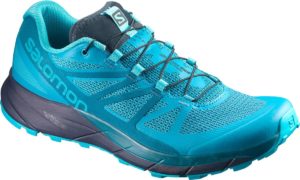What should be running shoes?
The right choice of running shoes will provide comfortable, painless and proper training. It depends on the shoes how quickly the legs will tire during the run, whether the muscles will hurt after training.
Shoe size
 The most important thing is to choose the right shoe size. Sneakers should be comfortable. The weight of training sneakers should not exceed half a kilogram.
The most important thing is to choose the right shoe size. Sneakers should be comfortable. The weight of training sneakers should not exceed half a kilogram.
During the fitting, the shoes should fit completely to the foot. Sneakers must be laced and walk, and if possible, go over the store. It is important that the fit of the shoe is complete, but not cramped.
Please note that while running, the foot slightly increases in width due to the load, so it is necessary to make a margin of 0.5-1 centimeters in the toe during fitting. You should move your fingers freely.
It is also worth paying attention to the place of the bend. Sneakers need to be bent around the toes, not in the middle of the shoe. To check where the fold line goes, you need to rest your toe on the floor and push on the heel. After that, it will become clearly visible in which part of the shoe the fold line passes.
Another important point: when trying on shoes, it is better to wear socks in which you will train. As a rule, training leggings are slightly thicker than ordinary synthetic socks, and this can affect the chosen shoe size and, as a result, the comfort of training.
Choosing running shoes depending on coverage
 Running shoes must be selected depending on the place of training: asphalt, gym, rough terrain.
Running shoes must be selected depending on the place of training: asphalt, gym, rough terrain.
For training on asphalt, sneakers with a soft sole are better suited. When running on asphalt and other hard surfaces, shoes should have sufficient cushioning to reduce pain in the ankle. To avoid slipping, sneakers should have a low tread with a furrow pattern for running on asphalt.
For running on synthetic surfaces, lightweight sneakers with a small tread and a light, open top are suitable. Usually, these are sneakers with mesh material on the toe.
In fact, the same sneakers are suitable for asphalt, a stadium and gyms.
For running on rough terrain, it is already necessary to choose heavier sneakers with a hard toe, with rigid fixation of the foot, especially the heel. The tread depth on these sneakers should be about 1 centimeter. It is also important that the sneakers have a large tongue. It will allow you to additionally fix the foot, and also prevent the penetration of dirt and small stones inside the shoe.
For training in the winter, it is worth choosing sneakers from a membrane, water-repellent fabric. It prevents moisture from entering and protects your feet from getting wet much better than skin. The tread on such shoes should be deep, and it is better that there are spikes on the sole.
- How to choose a vacuum cleaner taking into account the characteristics of the house and coatings?
- What to look for when choosing a water delivery
- How to quickly create comfort at home - tips for housewives
- How to choose the perfect TV - useful tips
- What to look for when choosing blinds
- What should be running shoes?
- What useful things can you buy in a hardware store
- Iphone 11 pro max review
- Than iPhone is better than Android smartphones



